training and learning development survey 2020
In October 2020, amid all of the uncertainty this year has brought, we decided it would be good to know more about what’s going on for our customers and how they see the next 12-18 months of learning and development activities in their organisations. We were also intrigued to know a little about how things have been during the pandemic. So, we did an online survey.
You can read more about how we did the survey and who responded later. For now, we should say it wasn’t a rigorous ‘scientific’ process. We reached out to a selection of customers to see whether they would take part, then sent them the survey. We also shared the link via social media. In the end, we got 47 respondents. So, you should treat the results as more qualitative than quantitative, indicative rather than definitive.
outlook
Compared with this time last year, respondents were marginally more likely to feel ‘more optimistic’ (34%) than ‘less optimistic’ (26%) about the outlook for L&D activities in their organisation, though a simple majority of respondents felt ‘the same’ (40%).
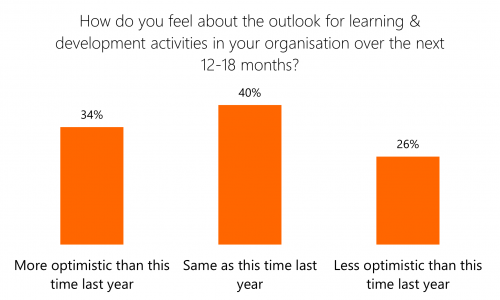
“It’s been a good opportunity to recalibrate. I expect things will keep changing!”
“We’re planning 2021 to be the same as 2020 – totally remote – and will revert to normality as and when we can.”
[L&D activities have] certainly reduced for our organisation which is a shame. But I think it may well be changing as we all realise this is the new normal and working at home will continue.”
budgets
When it came to their organisational training budgets, fewer than one in ten respondents predicted an ‘increase’ (9%), though four out of ten expected it to ‘stay the same’ (40%). A sizeable minority of respondents said their budget looked likely to ‘decrease’ (30%), while others simply didn’t know (21%).
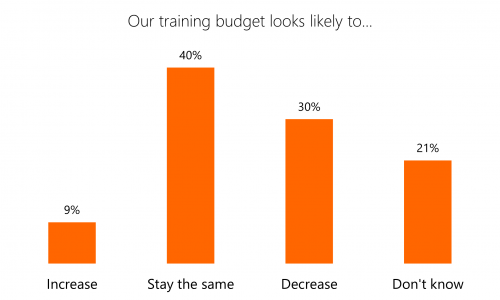
“The budget is significantly slashed for 2021 – we are really looking ahead to a much more robust business case for 2022 – evaluation is critical for this – what happened afterwards, what behaviours changed post the training not just the intention to change.”
methods
Most respondents expected the blend of training methods would change in their organisation (98%), with more online learning and development experiences taking the place of face-to-face ones. All of which makes perfect sense in the midst of a pandemic that has led to high levels of working from home (WFH).
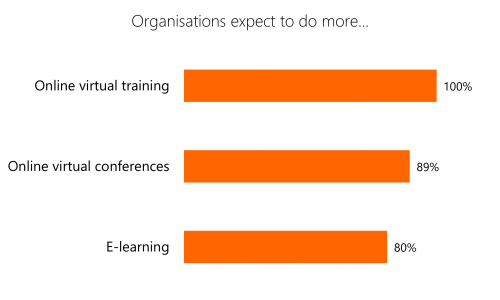
It will be interesting to see the extent to which changes sustain in the post Covid-19 training landscape. Some respondents were clearly enthusiastic about what’s happened, while others were not quite so sure.
“Whilst there have been some negative impacts, I really like the fact [the pandemic] has forced or expedited different approaches and greater use of technology.”
“[The pandemic and WFH] has accelerated initiatives that support the ability to provide virtual/ online/ bite sized learning support, that would have taken a lot longer to implement if working business as usual.”
“As horrendous as the pandemic has been for so many people, for L&D in the NHS it has enabled virtual training to become a reality and will support more digitally enhanced delivery in the future.”
“I have been surprised at how well virtual workshops and conferences have worked – many more people are more accepting of it as a tool and it brings with it more equality and flexibility.”
“I still question if eLearning is as effective as face to face/ classroom/ experiential learning. To me it’s more of a ‘compliance, tick box’ exercise. Or am I just old fashioned?”
priorities
Selected from a list, the top three priorities training and learning development priorities respondents identified were diversity and inclusion (66%), resilience and employee wellbeing (64%), and inclusive leadership (57%).
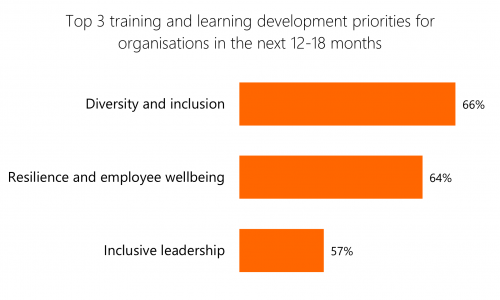
It’s worth noting here that these priorities could well reflect the specific interests of our customers (the principal focus of our survey), rather than those of organisations in general at this time. With that said, it’s not difficult to see that many organisations will be facing unique and pressing challenges in these areas. Whether that’s in response to the pandemic and its impact on working life or because of other significant events, such as the death of George Floyd and the Black Lives Matter demonstrations.
working from home
In the first of our Covid-19 specific questions, we asked respondents roughly how many of their employees are currently working from home (WFH) for the majority of their working week. A majority of respondents, three out of five (60%), said that more than half of their workforce were currently WFH. At the top end of the scale, almost one in four respondents (23%) said that more than nine out of ten employees were WFH.

For those pondering the potential long-term impact of Covid-19 on activities like training and learning development, it’s important to note that every respondent expected more employees in their organisation will be WFH after the pandemic than did before. It is, of course, possible that face-to-face training could become one of the key ways that teams come together in the ‘new normal’, building group cohesion and team spirit, but going with online options will clearly represent the path of least resistance in a predominantly virtual workplace.
support for employees
On average, respondents gave their organisations 4.3 stars for the way they had supported employees and enabled them to do their best in the circumstances during the pandemic.
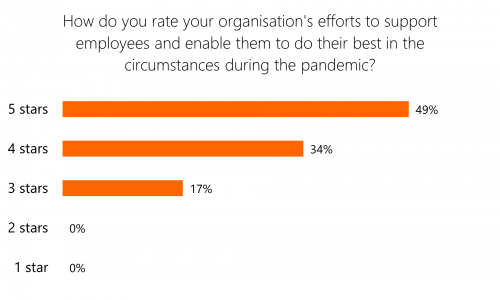
When reflecting on what else could have been done, or done better, respondents clearly recognised the unprecedented nature of the challenge represented by a global event of this kind.
“Given the sudden nature of working at home it would be challenging to say what could have been done better at the time… overall the feedback from staff has been that the organisational response has generally been positive and the interventions, communication and overall care for staff welcomed.”
“We have focused a lot actually and done largely a great job.”
“They have been quite inspirational in their handling of the situation.”
The two main areas of learning highlighted by respondents were:
- Looking out for employee wellbeing and mental health, including how managers handled remote teams
“We underestimated the mental health impact of working from home, especially for those who live alone. Although we advised teams to have regular ‘virtual team meetings’ in the event not every team did this, and we should have monitored this.”
“Increase focus on well-being and engagement.”
“Staff surveys revealed that some staff did not receive the support from their line managers that we would have expected, which we are addressing.”
“Line manager engagement on a personal level rather than purely professional.”
- Properly equipping employees for WFH (e.g. IT hardware, workstations, software)
“In hindsight we could have had a more efficient system of getting IT kit to people (this only took a few weeks to set up but was a cause of worry for some people).”
“Needs better IT, demanding software apps required for productive WFH are crippling many teams.”
“Risk assess workstations at home”
final thoughts
It’s clear that our survey respondents, like all of us, have been dealing with considerable upheaval and uncertainty in their working lives.
What also comes across is that they’ve not simply been battening down the hatches and waiting for the storm to pass, they’ve been adapting, trying out new approaches, and in many instances finding themselves pleasantly surprised with the results. Perhaps this is why there weren’t higher levels of pessimism about the outlook for L&D activities in the next year or so.
And, when medical science saves the day and brings this virus to heel, our survey suggests that lots of us don’t expect the world of work, and with that the ways we train, learn and develop together to ever go back to what they were.
“The pandemic has thrust us 10 years into the future.”
Training and learning development activities are going online like never before. It’s not just eLearning, it’s online training sessions and conferences. This means those creating content will need to find ways to hold an audience with access to emails and messaging, pressing tasks, and the myriad distractions of the internet. More than that, they will need to find ways to actively engage people, to help them feel and see things that will lead them to change the ways they behave and potentially even think. In that sense, the challenge for L&D professionals remains the same as ever; to help busy people learn and make a positive difference.
“We’ve already adapted hugely although it’s been a steep learning curve! It’s great to see the training sector have largely done the same, although I do have one contact refusing to take their training online (it certainly isn’t Enact). This absence of flexibility will influence me using them again.”
Which brings us to our last take-away from the survey results. The ‘new normal’ means new challenges for trainers and L&D professionals to help organisations address. Or at least, new versions of old challenges. A significant increase in WFH doesn’t just present practical ‘getting the job done’ hurdles for organisations to overcome, it brings a whole new dimension to nurturing shared values, to inclusion and helping people feel like part of a team, to coaching and helping them grow and fulfil their potential, and to looking after their emotional and mental wellbeing. As we contemplate the future, one thing’s for sure, there’s lots for us all to get stuck into.
“Biggest challenges are maintaining culture and values in an asynchronous remote working setup, without the opportunities for spur-of-the-moment, spontaneous coaching opportunities.”
“I think the interesting thing will be if / when we have more of a blend of associates who are home based, and office based. It means more effort will need to be put into inclusive meetings, etc.”
“Those who are creative problem solvers with high level of EQ have the opportunity to produce meaningful interventions.”
methodology
The online survey ran from 22 Oct to 5 Nov 2020. It was sent to 101 Enact Solutions customers who had been approached and expressed an interest in taking part. It was not a random sample. The link was also shared on social media.
In total there were 47 respondents. A majority of these were our customers, while 10 came from our social media postings.
We received responses from individuals working in organisations across a range of sectors:
- Health, Hospital, Clinic, GP Surgery
- Education
- Energy, Chemical, Utilities
- Consulting
- Medical, Pharma, Biotech
- Financial Services
- Central Government
- Manufacturing
- Advertising/ Marketing/ PR
- Aerospace & Defence
- Banking & Securities
- Local Government
- Insurance
- Legal
- Retail
- Telecommunications
Organisations ranged from SMEs to large multinationals.
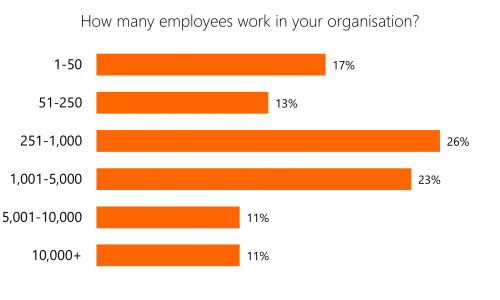
David Allen
David Allen is Director of Impact at Enact Solutions.



